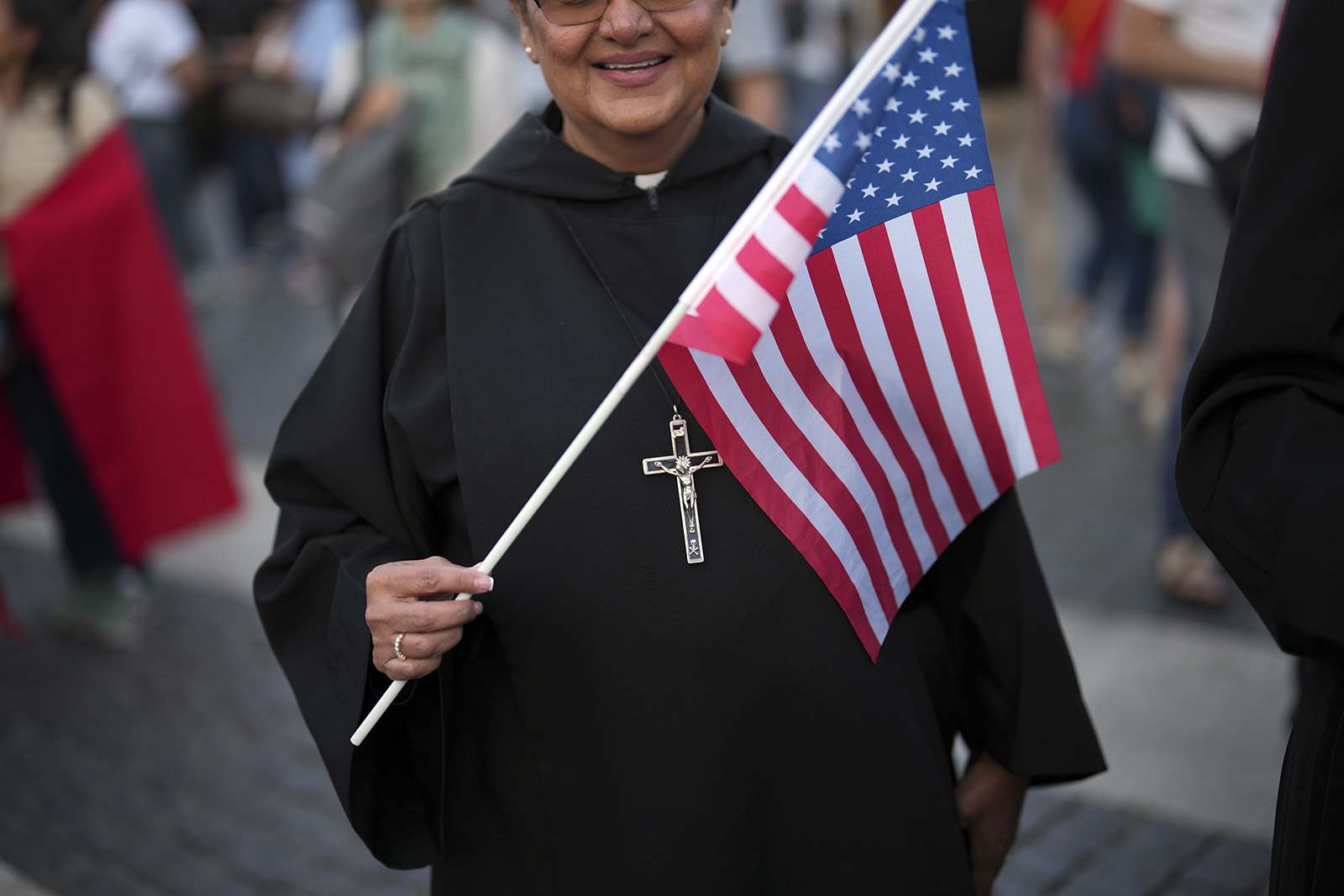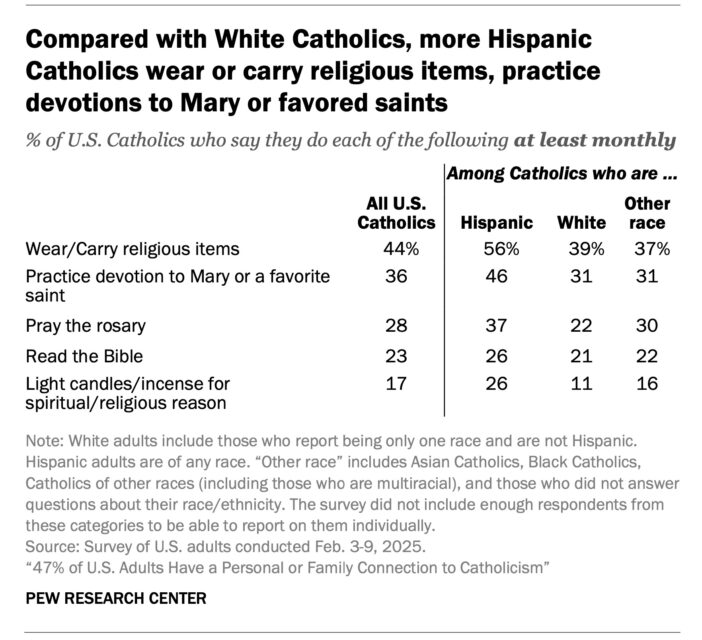
(RNS) — While reporting relatively low levels of attendance at Mass, almost half of U.S. adults (47%) say they have a personal or family relationship to Catholicism, a new Pew Research Center survey finds.
The survey found that 1 in 5 U.S. adults identify as Catholic, and another 9% say they don’t identify with Catholicism religiously but answered yes when asked “whether ‘aside from religion’ they consider themselves Catholic in any way.”
An additional 9% identify as former Catholics, and another 9% say they have a Catholic parent or partner or that they have attended Catholic Mass.
Yet fewer than 3 in 10 adults (28%) of those 20% who identify as Catholic in the religious sense attend Mass at least weekly, and slightly less than a quarter (23%) attend Confession yearly.
The survey was conducted from July 2023 to Feb. 2025, before the April 2025 death of Pope Francis and the election of his successor, Pope Leo XIV, the first American pontiff, in May.
A 2019 Pew survey inspired U.S. Catholic bishops to redirect their plans for evangelization after it found that only a third of Catholics believed church teaching that Jesus is present in the consecrated bread and wine at Mass, sparking concern among the U.S. Catholic bishops. Though some academics criticized the survey’s wording and called its finding unreliable, the result prompted the bishops to launch a three-year evangelization campaign in 2022 aimed at drawing more Catholics to Sunday Mass.

“Nearly half of Americans have Catholic connections” (Graphic courtesy Pew Research Center)
Through the National Eucharistic Revival, first envisioned by Winona-Rochester, Minnesota, Bishop Robert Barron, the bishops had hoped their evangelization campaign would instill renewed respect for the Eucharist.
Pew’s 2025 survey does not include a question about belief in the real presence of Jesus in the bread and wine, but it does shed light on Catholic piety and practices and even contains a question about the influence of revival itself.
Three in 10 U.S. Catholics said that they had heard about the 2024 National Eucharistic Congress, the culminating event of the revival held in July 2024, but that share rose sharply among Catholics who attend Mass more often.
More than half (55%) of weekly Mass attendees said they had heard at least a little about the congress, while a smaller share, 40%, said that they’d heard at least a little about the Synod on Synodality, a three-year-long dialogue process involving listening to everyday Catholics’ concerns about the church.
Some Catholic leaders, including Lexington, Kentucky, Bishop John Stowe, had predicted the National Eucharistic Congress would pull focus from the synod, one of Francis’ signature theological efforts.

“Most Catholics say having a relationship with Jesus is essential to what being Catholic means to them” (Graphic courtesy Pew Research Center)
Overall, fewer than a quarter of all U.S. Catholics (23%) had heard about the synod.
Pew asked what was “essential” to being Catholic to them, giving participants 14 possible elements to respond to.
More than half said that “having a personal relationship with Jesus Christ” (69%) is essential, and exactly half said devotion to the Virgin Mary is essential. Slightly less than half of Catholics named “helping the poor and needy” (47%) or receiving the Eucharist (46%) as essential.
Unsurprisingly, Catholics not attending Mass weekly were significantly less likely to say that receiving the Eucharist (32% compared to 83% of weekly attenders), getting married in the church (28% compared to 70% of weekly attenders) or being part of a Catholic parish (16% compared to 67% of weekly attenders) were essential to what being Catholic meant to them.
Some of the “essential” elements touched on political issues, such as “opposing abortion,” “caring for immigrants” and “taking care of the environment,” and the results were predictably partisan.
Hispanic Catholics were much more likely to say caring for immigrants (47% compared to 20% of white Catholics), devotion to the Virgin Mary (63% compared to 42% of white Catholics) and protecting the environment (43% compared to 24% of white Catholics) were an essential part of “being Catholic” to them.
The survey also revealed Hispanic Catholics were significantly more likely than white Catholics to wear or carry religious items, practice devotion to Mary or a saint, pray the rosary or light candles or incense.
Hispanic Catholics are more likely to go to confession once a year (28%) than white Catholics (20%), yet they are significantly less likely to receive Communion most of the time when they go to Mass (34% compared to 58% of white Catholics).
Catholics are instructed to go to Confession before receiving Communion, especially after committing particularly serious or “mortal” sins. But norms and customs among Hispanic Catholics about abstaining from Communion tend to be more prevalent.
The majority of Hispanic Catholics attend a Mass in Spanish some of the time, with 38% usually attending in Spanish and another 23% attending sometimes in English and sometimes in Spanish. About a quarter (26%) usually attend in English.

“Compared with White Catholics, more Hispanic Catholics wear or carry religious items, practice devotions to Mary or favored saints” (Graphic courtesy Pew Research Center)
In terms of parish life, the survey revealed that Catholics hold generally favorable views of their parish priests. Ninety-five percent of weekly Mass attendees view their parish priest favorably, and 71% of all Catholics said the same. More than half of weekly Mass attendees (54%) had “very favorable” views compared to 32% of all Catholics.
And while a vocal minority of conservative Catholics excoriate those U.S. bishops who discourage practices such as the Tridentine Mass or receiving Communion on the tongue, 62% of those who attend Mass weekly prefer to receive Communion in the hand, while just 2 in 10 (21%) prefer to receive on the tongue.
Only 13% of Catholics have ever attended a Mass said in Latin with the priest facing the altar instead of the people in the pews, often known as the Traditional Latin Mass, and only 2% of Catholics attend that Mass weekly. Among weekly Mass attendees, only 6% go weekly or once a month to a Tridentine Mass, though about 2 in 10 (22%) have attended at some point.
Francis suppressed the celebration of that Latin Mass because of concerns that its adherents did not respect the reforms of the Second Vatican Council, but some of the proponents of that Mass hope that Leo will ease those restrictions.
Of former Catholics, or cultural Catholics who said they were raised religiously Catholic, the survey asked an open-ended question about why they left the faith and then created categories from the answers.
Almost 2 in 10 (18%) who left the church said they had “changed beliefs” or “hold different beliefs” or their “values don’t align with the church. About 1 in 10 said they were “never that committed in the first place or grew away from it” (10%), stopped believing in God or disavow religion (9%) or cited abuse scandals (8%).
Six in 10 (62%) of current U.S. Catholics say reports of Catholic clergy sex abuse “reflect ongoing problems,” slightly down from 69% in 2019. The majority of Catholics also say that sexual abuse is equally common among other religious leaders as among Catholic priests, as well as other adults working with children as among clergy.
Among the many other answers former and cultural Catholics gave for leaving the church were a perceived lack of biblical basis for Catholicism (6%), the role of women or abortion (4%), hypocrisy (4%), a perception of corruption (3%), inability to get married in the church/their spouse not being Catholic (3%) and the church’s treatment of LGBTQ+ people (3%).
Compared to those who have left, many fewer U.S. adults have converted to Catholicism — 1.5% of U.S. adults and 8% of U.S. Catholics — but the most prominent reason for converting was to marry a spouse in the church or because of a partner, with roughly half (49%) giving that reason.
The next most common reasons were that they “came to believe in the teaching or historical foundations of the Catholic Church” (13%), “felt called to Catholicism or found it spiritually fulfilling” (12%) and “the influence of family and friends” (12%).
Catholic converts are much more likely to receive Communion every time they go to Mass (58% compared to 34% of cradle Catholics), and they are more likely to attend Mass weekly (38% compared to 28% of cradle Catholics). They are equally likely to go to the Tridentine Mass, and similar shares describe themselves as conservative, moderate and liberal compared to cradle Catholics.
The Pew report mostly relies on a Feb. 2-9, 2025, survey that was conducted among a sample of 9,544 U.S. adults, including 1,787 Catholics.
This story has been updated.
